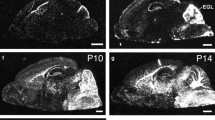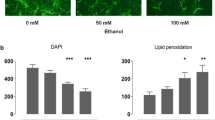Summary
During mouse brain maturation cellular transglutaminase specific activity increases 2.5 fold from day 3 to adulthood. A more pronounced increase is seen during morphological differentiation of mouse neuroblastoma cells, where serum withdrawal induces neurite outgrowth concomitant with a 10 fold increase in transglutaminase specific activity. In contrast, non-dividing neuroblastoma cells lacking neurites show only a 1.5 fold increase in enzyme specific activity. Transglutaminase activity does not reach maximal levels until extensive neurite formation has occurred. More than 80% of the transglutaminase activity is found in the soluble component of brain and neuroblastoma homogenates. Using [3H]-putrescine as the acyl acceptor, endogenous acyl donor substrates in the neuroblastoma cells included proteins that comigrated on SDS-PAGE with tubulin and actin; however, very high molecular weight crosslinked material is the major reaction product in vitro. When purified brain tubulin, microtubule associated proteins and microtubules were compared as exogenous substrates, only the polymeric microtubules were a good acyl donor substrate. Furthermore, preincubation of purified tubulin with transglutaminase and putrescine stimulated both the rate and extent of microtubule assembly. These findings suggest that transglutaminase may mediate covalent cross-linking of microtubules to other cellular components, or the post-translational modification of tubulin by the formation of γ-glutamylamines.
Similar content being viewed by others
References
Ellisman M, Porter K: Microtrabecular structure of the axoplasmic matrix: visualization of cross-linking structures and their distribution. J Cell Biol 87:464–479, 1980.
Hirokawa N: Cross-linker system between neurofilaments, microtubules, and membranous organelles in frog axons revealed by the quick-freeze, deep-etching method. J Cell Biol 94:129–142, 1984.
Griffith L, Pollard T: The interaction of actin filaments with microtubules and microtubule-associated proteins. J Biol Chem 257:9143–9151, 1982.
Runge M, Lane T, Yphanthis D, Lifaics M, Sarato A, Altin M, Rinke K, Williams Jr RC: ATP-induced formation of an associated complex between microtubules and neurofilaments. Proc Nat Acad Sci USA 78:1431–1435, 1981.
Folk JE: Transglutaminases. Ann Rev Biochem 49:517–531, 1980.
Lorand L, Conrad M: Transglutaminases. Mol and Cell Biochem 58:9–35, 1984.
Lorand L, Weissman L, Epel D, Bruner J: Role of the intrinsic transglutaminase in the Ca+2 mediated crosslinking of erythrocyte proteins. Proc Nat Acad Sci USA 73:4479–4481, 1976.
Levitzki A, Willingham M, Pastan I: Evidence for participation of transglutaminase in receptor-mediated endocytosis. Proc Nat Acad Sci USA 77:2706–2710, 1980.
Rice R, Green H: The cornified envelope of terminally differentiated human epidermal keratinocytes consists of cross-linked proteins. Cell 11:417–422, 1977.
Birckbichler P, Orr G, Patterson M, Conway E, Carter H: Increase in proliferative markers after inhibition of transglutaminase. Proc Nat Acad Sci USA 78:5005–5008, 1981.
Pohjanpelto P, Virtanen I, Hollta E: Polyamine starvation causes disappearance of actin filaments and microtubules in polyamine-auxotrophic CHO cells. Nature 293:475–477, 1981.
Seeds NW, Maccioni RB: Transglutaminase and the neuronal cytoskeleton (Abstract). Trans Amer Soc Neurochem 14:100, 1983.
Seeds NW, Gilman A, Amano T, Nirenberg M: Regulation of axon formation by clonal lines of a neural tumor. Proc Nat Acad Sci USA 66:160–167, 1970.
Morgan JL, Seeds NW: Tubulin constancy during morphological differentiation of mouse neuroblastoma cells. J Cell Biol 67:136–145, 1975.
Seeds NW, Maccioni RB: Proteins from morphologically differentiated neuroblastoma cells promote tubulin polymerization. J Cell Biol 76:547–555, 1978.
Azari P, Rahim I, Clarkson D: Transglutaminase activity in normal and hereditary cataractous rat lens. Curr Eye Rev 1:463–469, 1981.
Weingarten M, Lockwood A, Hwo S, Kirchner M: A protein factor essential for microtubule assembly. Proc Nat Acad Sci USA 72:1858–1862, 1975.
Maccioni RB, Seeds NW: Limited proteolysis of tubulin: nucleotide stabilizes on active conformation. Biochemistry 22:1567–1572, 1983.
Laemmli UK: Cleavage of structural proteins during the assembly of the head of bacteriophage T4. Nature (London) 227:680–685, 1970.
Maccioni RB, Seeds NW: Affinity labeling of tubulin exchangeable GTP binding site. Biochemistry 22:1572–1579, 1983.
Ogawa H, Goldsmith LA: Human epidermal transglutaminase: Preparation properties. J Biol Chem 251:7281–7288, 1976.
Ambron RT, Krenzner LT: Post-translational modification of neuronal proteins: evidence for transglutaminase activity in R2 of Aplysia. Proc Nat Acad Sci USA 79:3442–3446, 1982.
Cariello L, Wilson J, Lorand L: Activation of transglutaminase during embryonic development. Biochemistry 23:6843–6850, 1984.
Erickson H, Voter WA: Polycation induced assembly of purified tubulin. Proc Nat Acad Sci USA 73:2813–2817, 1976.
Lee JC, Tweedy N, Timasheff SN: In vitro reconstitution of calf brain microtubules: Effects of macromolecules. Biochemistry 17:2783–2790, 1978.
Selkoe DJ, Abraham C, Ihara Y: Brain transglutaminase: In vitro crosslinking of human neurofilament proteins into insoluble polymers. Proc Nat Acad Sci USA 76:6070–6074, 1982.
Author information
Authors and Affiliations
Rights and permissions
About this article
Cite this article
Maccioni, R.B., Seeds, N.W. Transglutaminase and neuronal differentiation. Mol Cell Biochem 69, 161–168 (1986). https://doi.org/10.1007/BF00224763
Received:
Issue Date:
DOI: https://doi.org/10.1007/BF00224763




